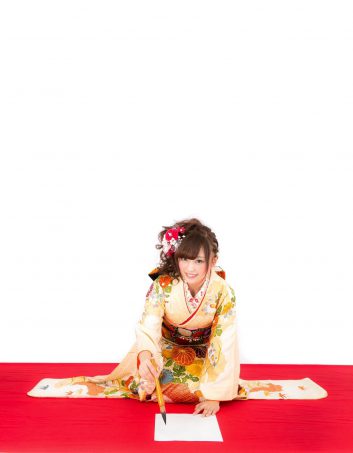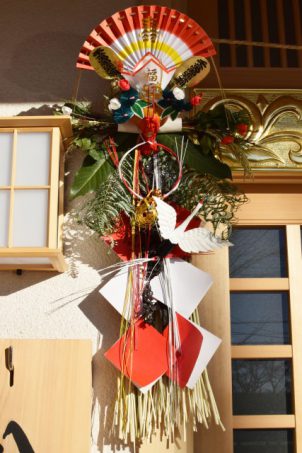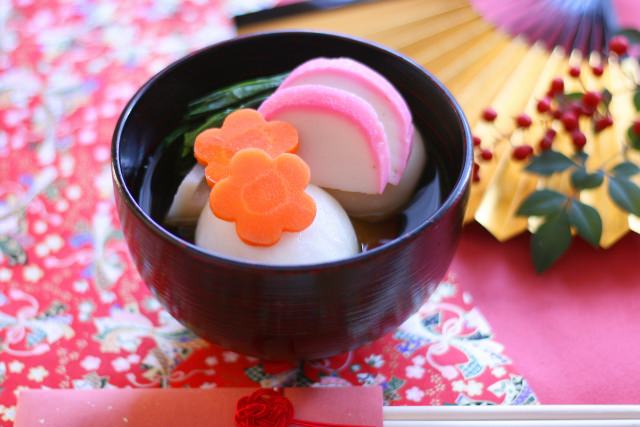Oshougatsu : How Japanese Celebrate New Year

New Year is called Oshougatsu in Japanese.
Most companies are closed, except for some retail stores, hospitals, etc. until 3rd January.
You notice how calm outside is, especially, on 1st January if you go out.
But on the contrary, some places become very busy with people between 1st and 3rd January.
What Japanese people usually do in this Oshougatsu?
Let’s take a look!
Placing Decoration of Straw Rope Shimekazari

Shimekazari is a decoration of Sacred rice-straw rope.
People display it on the door or entrance to the house on New Year.
Shimekazari is for welcoming the Toshigami or Shinto Deity and showing the place is a sacred place.
You also might have seen a big tall tree wrapped around this rice straw.
The rice straw means spiritual boundary between sacred area and the actual world.
Inside of the rice straw is considered to be sacred area.
Hatsumoude

Hatsumoude is visiting a shrine on New Year’s Day.
Shrines, that have no need to line usually, get tons of people for praying.
People do Hatsumoude to show gratitude to Shinto Deity for the past year and pray for the well‐being of one’s family and sound health of the year.
Most people visit shrine between 1st and 3rd of January that most of all the main shrines or temples are really crowded.
It sometimes takes an hour from the first gate to the main shrine or temple.
I myself visited 5 popular shrines and temples in Tokyo in this 2017 and was surprised at the scene.
You can see how it was here Hatsumoude in Tokyo Visited 5 popular shrines.
But I recommend you to visit shrine or temple on New Year’s Day as you can feel “the Japan” there.
Enjoy Fortunate Food Osechi, Ozouni, Rice Cake
- Osechi

Osechi Ryouri is the food eaten on New Year Holiday.
It is served in traditional multi-tiered lacquer box called Jyubako.
Various types of fortunate foods are beautifully arranged inside.
Each tier and each foods inside have special meaning.For example, first tier Ichi no Jyu is filled with boiled fish paste of red and white, mashed sweet potatoes with sweetened chestnuts, sweet rolled omelet, etc.
Fish paste of red symbolizes happiness and joy, white means holiness.
Mashed sweet potatoes with sweetened chestnuts represents money fortune.
Sweet rolled omelet means gay and luxuriance.All the foods are not just crammed into each tier without rule.
First tier ichi no jyu is only for the foods that goes well with Sake.Second tier Ni no Jyu is only for grilled fish and vinegared vegetables.
Third tier is only for boiled dishes.
It becomes course menu like Japanese Kaiseki Ryori.
Combination of dishes and beautiful appearance in each tiers are important.This Osechi is kept served not only on 1st of January but 2nd, 3rd until inside Jyubako becomes empty.
You might think foods inside go bad if it take several days to finish.
For that, they are all heated or vinegared.Osechi also served for the meaning of getting good rest without complicated cooking at least these 3 days on New Year.
It is also for the mother or the person who always makes a dish for the family, isn’t it.I really like this Osechi but there are certainly many people who don’t like Osechi that much.
Because more than half of the foods are sweet taste and people are getting tired of having same kind of foods for days.That is understandable that there are other food such as Ozouni or some people eat out.
- Ozouni

Ozouni is a special food eaten on New Year’s Day.
It is filled with many vegetables, seafood, rice cake, etc.But the ingredients inside differ widely depends on the place you live in Japan.
For example in Kanto area that is around Tokyo eat Ozouni that includes chicken, Japanese radish, carrot, baked rectangular rice cake and base of the soup is soy sauce.
But people in Kansai area that is around Osaka and Kyoto use mainly vegetables (some areas add fish, too), round rice cake, and base of the soup is miso or fermented soy bean paste.
I was born in Kanto area but my mother was in Kansai that I always had more like Kansai style Ozouni and I thought everyone is having exact same thing in New Year’s Day when I was little.
It is said that eating Ozouni is to get a bless and benefit of Shinto deity.By eating rice cake that offered to Shinto deity on New Year people thought they can get rich harvest and prosperity of the year.
- Rice Cake or Mochi

Like Ozouni, Mochi, or Rice Cake is eaten on New Year’s Day.
I often see rice cake sells at supermarket especially in this season.In the old days, people came together and made fresh rice cake by pounding glutinous rice using a mortar and a pestle.
But it takes time and people got much busier nowadays that I think most people buy prepared rice cake at supermarket.Famous rice cake of New Year is Kagami mochi.
It is a set of 2 or 3 round rice cakes and they are piled up with an orange on the very top.
It is said that this Kagami mochi should be displayed before 28th of last year.This is also offered to Shinto deity.
And it is displayed until 11th January.
On the 11th January it is cut off into pieces and eaten.Cutting of this Kagami mochi is called Kagami Biraki.
People eat rice cake praying for a blessing of the year.For more information of Mochi, I wrote the article of How to make Japanese rice cakes.
Enjoy Kite Flying, Japanese Traditional Badminton, Playing Cards
- Kite Flying Takoage

People came to enjoy Flying kite since Edo period.
It was not only just for a fun but has the meaning of prayer and protection in those days.I used to fly kite and it was so much fun.
It went high up in the air and I was sometimes afraid of being taken away with the kite as the strength of it was really powerful and I was little.I could see people flying kite in those days but I think not many people fly kite nowadays as there are not so much open spaces, especially in the city.
And it is cold outside in January.
But once you do it, it is really fun and you forget about the time. - Japanese Traditional Badminton Hanetsuki

Hanetsuki is a badminton-like game that is often played by girls.
Wooden paddles and shuttlecock are used in the game.This also have the meaning of warding off evil by hitting a shuttlecock.
If you won the game, you can write something on the loser’s face in India ink.It is a beautiful and traditional scene to see girls in Kimono enjoying Hanetsuki.
Although I rarely see the scene nowadays. - Playing Cards Hyakunin Isshu

When family or relatives come together, some of them enjoy playing cards ,or Hyakunin Isshu.
This is an anthology of 100 poems by 100 different poets.One person reads the poem and the others find and touch the appropriate card among 100 cards spread on the table or Tatami mat.
You need to find the card faster than the others to win the game.It is a good game of New Year as adult and child can enjoy together.
Line up for a Lucky Bag Fukubukuro

New Year’s Days is not only for traditional things but for modern shopping.
Every store such as clothes store, appliance store, cafe, etc. are selling lucky bag.
Popular lucky bags every year are Yodobashi camera, Apple, Tully’s Coffee, starbucks Coffee, etc.
As long as I checked the items inside from other’s video they are certainly good buy.
They are not odds and ends of dead stock of the store that I can understand the popularity.
But that means it sold out quickly that some people line up from very early morning on 1st day such as 3 am.
Both Apple or Yodobashi camera are really popular every year that even if you visit the store early morning such as 6 am you could see very long line of people.
Only Tully’s Coffee you can book in advance that no need to line up.
I also recommend you to challenge a lucky bag of village Vanguard if you are challenger.
It is really unique shop that handles strange and funny goods which you can’t see at ordinary store.
That some people, especially young people love the shop.
No one knows what’s inside that you might be able to get unique great goods you love but vice versa.
This long line of people also became one of the characters of New Year in Japan.
If you want to know more about the details and the contents of Lucky Bag, here I wrote the article of Top ranking of Fukubukuro 2018.
Fukubukuro Lucky Bag 2018 in Japan
Summary
I think New Year is a good chance to see and touch traditional culture of Japan.
Even though everywhere crowded.
If you are not good at crowded place it might be good to challenge flying kite, Hanetsuki and traditional cards.
People could get enough rest at the end of the year to at least 3rd January in the old days but as you can see from the long line of shop on 1st January, there are also people who work from the 1st.
I sometimes felt like it would be great if most people could get enough rest at least a couple of days at the end and the start of the year as people are always busy through the year.
But it is also true thanks to the people who work at there, we can get things or can go see a doctor without worrying anything.
Anyway this New Year is most important date I think in Japan.
People wish something every year on New Year when visiting Shrine or Temple.
It’s the fresh start of the year in Japan.
New Year’s Eve Omisoka in Japan
Hatsumode New Year Celebration Tokyo 2017 – Visited 5 popular shrines
Japanese New Year Post card Nengajo! Dog’s Year 2018!












